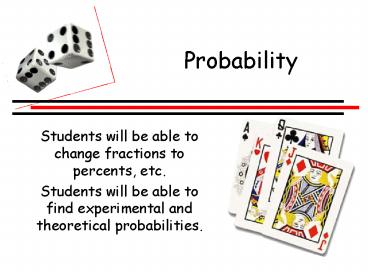Probability - PowerPoint PPT Presentation
1 / 17
Title:
Probability
Description:
... lottery, you pick 6 numbers from the numbers 1-50. If you match all 6 numbers, you win! ... that coin landing in that can than you do of winning the lottery! ... – PowerPoint PPT presentation
Number of Views:50
Avg rating:3.0/5.0
Title: Probability
1
Probability
- Students will be able to change fractions to
percents, etc. - Students will be able to find experimental and
theoretical probabilities.
2
Converting to Percents
- To convert a decimal to a percent, multiply the
decimal by 100. - Example .25 ? .25 x 100 25
- To convert a fraction to a percent, convert to a
decimal and then multiply by 100. - Example ¼ ? 1 4 .25 ? .25 x 100 25
3
Converting Percents
- To convert a percent to a decimal, divide the
percent by 100. - Example 35 ? 35 100 .35
- To convert a percent to a fraction, put the
percent over 100 and reduce fraction to lowest
terms (use your calculator). - Example 35 ?
4
What is Probability?
- A probability is expressed as a number between 0
and 1 that tells how likely an event is to
happen. - A probability of 0 means that the event has no
chance of happening. What is an example of an
event that is impossible.
Walking on Jupiter tomorrow.
5
What is Probability?
- A probability of 1 means that an event is certain
to occur. What would be an event that has a
probability of 1? - The sun coming up tomorrow.
- Any event that is between impossible and certain
has a probability between 0 and 1, and so is
usually written as a fraction.
6
Probability in Perspective
- In the California lottery, you pick 6 numbers
from the numbers 1-50. If you match all 6
numbers, you win! - There are 18,009,460 possible number
combi-nations. Here are some interesting facts
- If you filled out a card for each possible
combinations, and if you could fill out those
cards at the rate of one per second, it would
take you 208 days (working 24 hours a day) to
complete the task.
7
Probability in Perspective
- If you buy 50 Lotto tickets a week, you could
expect to win the Jackpot once in 5,000 years.
- If you bought 2 Lotto tickets a week for 110,000
years, you would have a 50 chance of winning the
jackpot at least once.
- Some people sell books to help you have a better
chance of winning You can increase your chance
of winning 100! Of course, you can increase
your chance of winning 100 by just buying 2
tickets instead of 1!!
8
Probability in Perspective
The probability of winning the Lotto is about 1
in 18 million
- You are 18 times more likely to die from
flesh-eating bacteria than to win the Lotto.
- You are 3600 times more likely to die of cancer
from eating a peanut butter sandwich every day.
- You are 600 times more likely to die being struck
by lightning.
- You are 28 times more likely to be dealt a royal
flush during the opening hand of a card game.
9
Probability in Perspective
- You and a friend could visit the Empire State
Building. - One of you stays on the street and walks
around the building holding a can, while the
other goes to the top and throws off a coin.
You have a better
chance of that coin landing in that can
than you do of winning the lottery!
10
What is an Experiment?
- Rolling a die, flipping a coin, or spinning a
spinner all of these are experiments. - If you were to flip a coin 50 times and you got a
head 30 times, the experimental probability would
be 30/50 which is 3/5 in lowest terms or 0.6 in
decimal form.
11
A Probability Experiment
- Spinning this spinner is an experiment. There
are 3 possible outcomes. - Suppose we spun the spinner 10 times and landed
on green 6 times. - What is the experimental probability that we
would land on green on the next spin?
6 greens 10 spins
The probability is
12
Conduct an Experiment
- Now, lets conduct a probability experiment.
- Get your pencil ready to write down a number when
I say. - Write down a number from 1 through 4.
- Lets see what was chosen most frequently.
- Was it 3? Studies have shown that 3
is the number written most
frequently. - What is the estimated probability that
the people in this class chose
3?
3
13
What Should Happen?
- If you were to toss a coin, how many possible
outcomes are there? - two
- Are each of these outcomes equally likely?
- yes
- Considering this, what should the probability be
for tossing a head?
½
14
Theoretical Probability
- Theoretical Probabilities are determined by what
should happen, ideally. - When dealing with equally likely outcomes
- P(E)
Number of favorable outcomes
Total number of possible outcomes
15
Examples of Theoretical Probability
- Thus, the theoretical probability of tossing a
Head, when flipping a coin is? - The theoretical probability of tossing an odd
number when tossing a die is? - or ½
½
16
Sample Space
- The set of all possible outcomes of an experiment
is called the sample space. - When more than one event occurs, you need a way
to find all the possible outcomes. - The easiest way to do this is with a tree
diagram.
17
Tree Diagram
- A person flips a nickel and then spins this
spinner
(H, R) (H, G) (H, Y)
Red Green Yellow
H T
Red Green Yellow
(T, R) (T, G) (T, Y)































